Abstract
The snowshoe hare (Lepus americanus) could be infected with western equine encephalomyelitis (WEE) virus and produce a viremia. Furthermore, viremia in hares exposed to variable climatic conditions differed significantly from viremias seen in the control animals held at constant temperatures. The viremia duration and titer were increased in animals subjected to fluctuating temperature and humidity. The time of onset of viremia was accelerated. Antibody response also increased in animals exposed to varying temperatures when compared with controls held at constant temperature and humidity. Snowshoe hares were studied at two distinct seasonal periods: winter, before reproductive activity; and summer, during reproductive midseason. Winter animals experienced greater viremia than did summer hares when exposed to fluctuating temperatures, suggesting a seasonality in the hare's susceptibility to host modification by environmental influences. These findings implicate the snowshoe hare as a possible mammalian amplifying host for WEE virus in the boreal forest.
Full text
PDF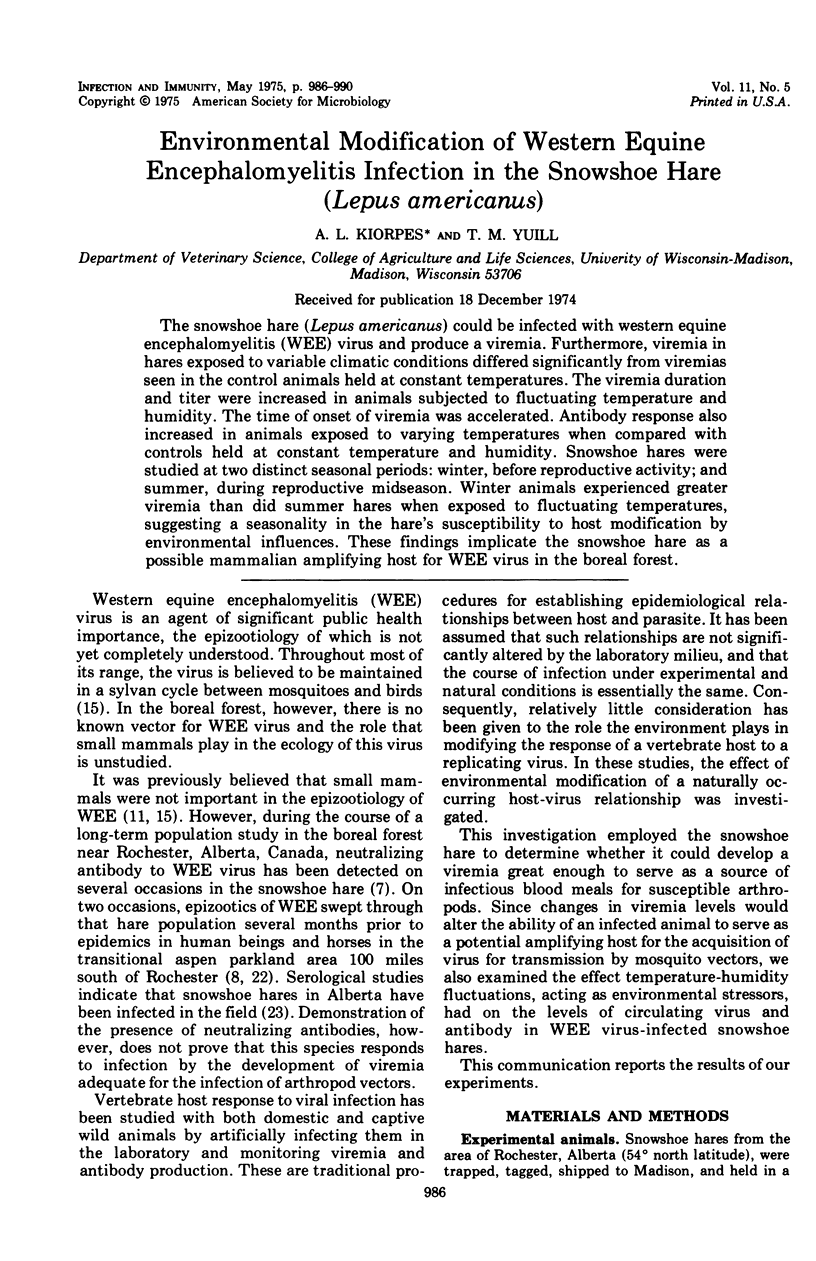
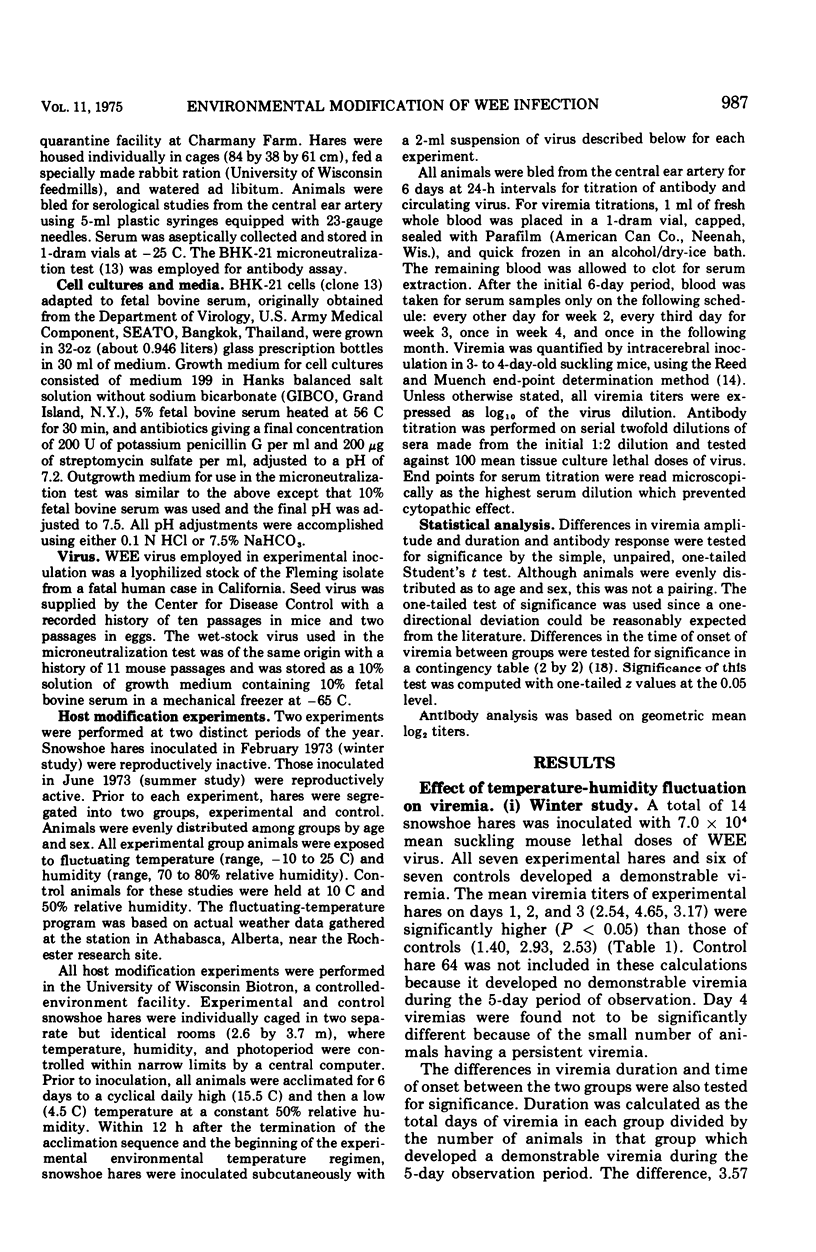
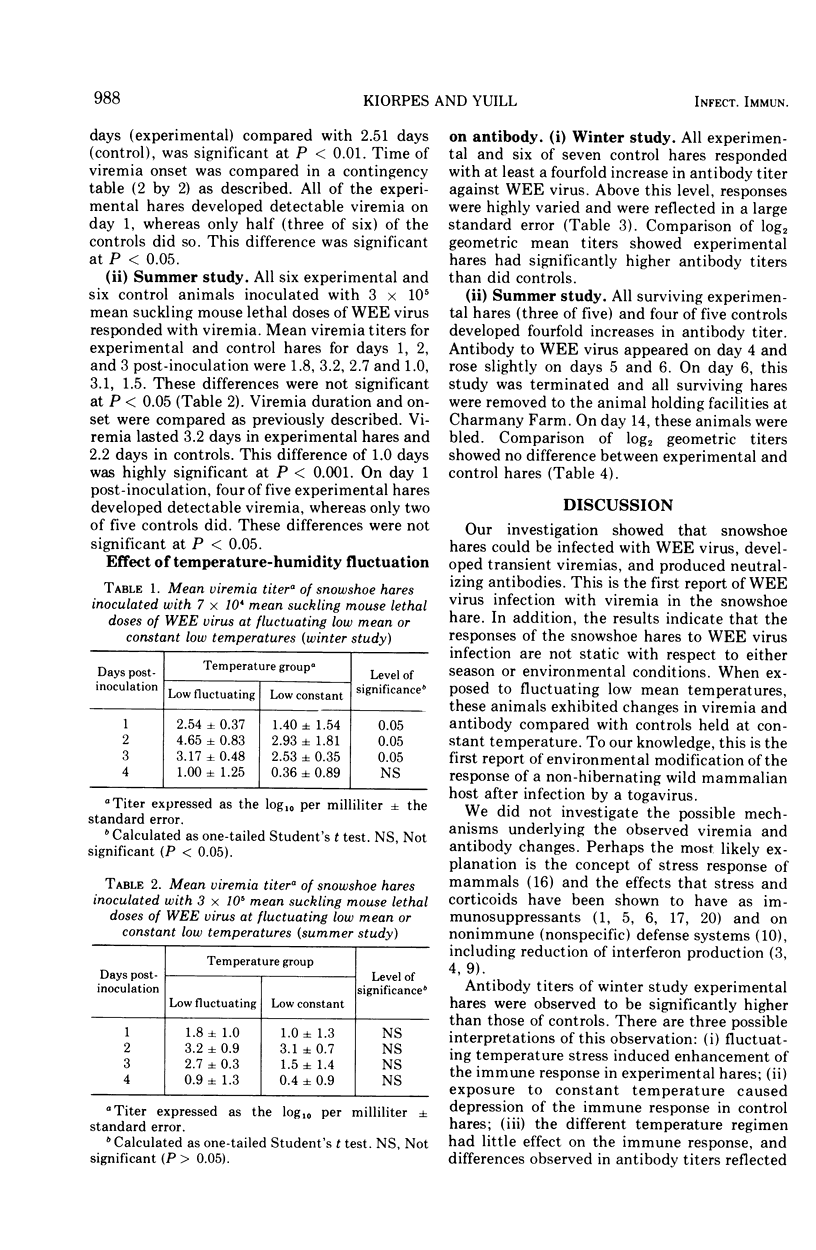
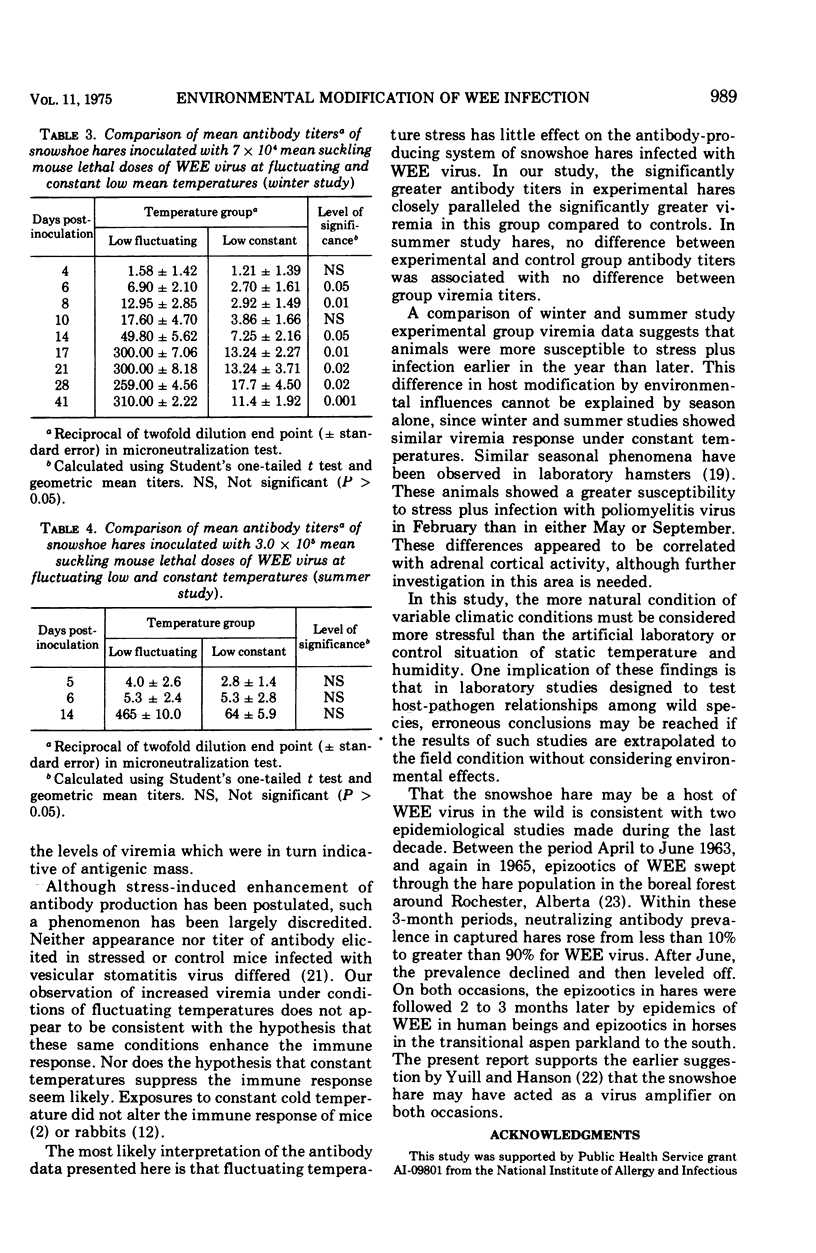
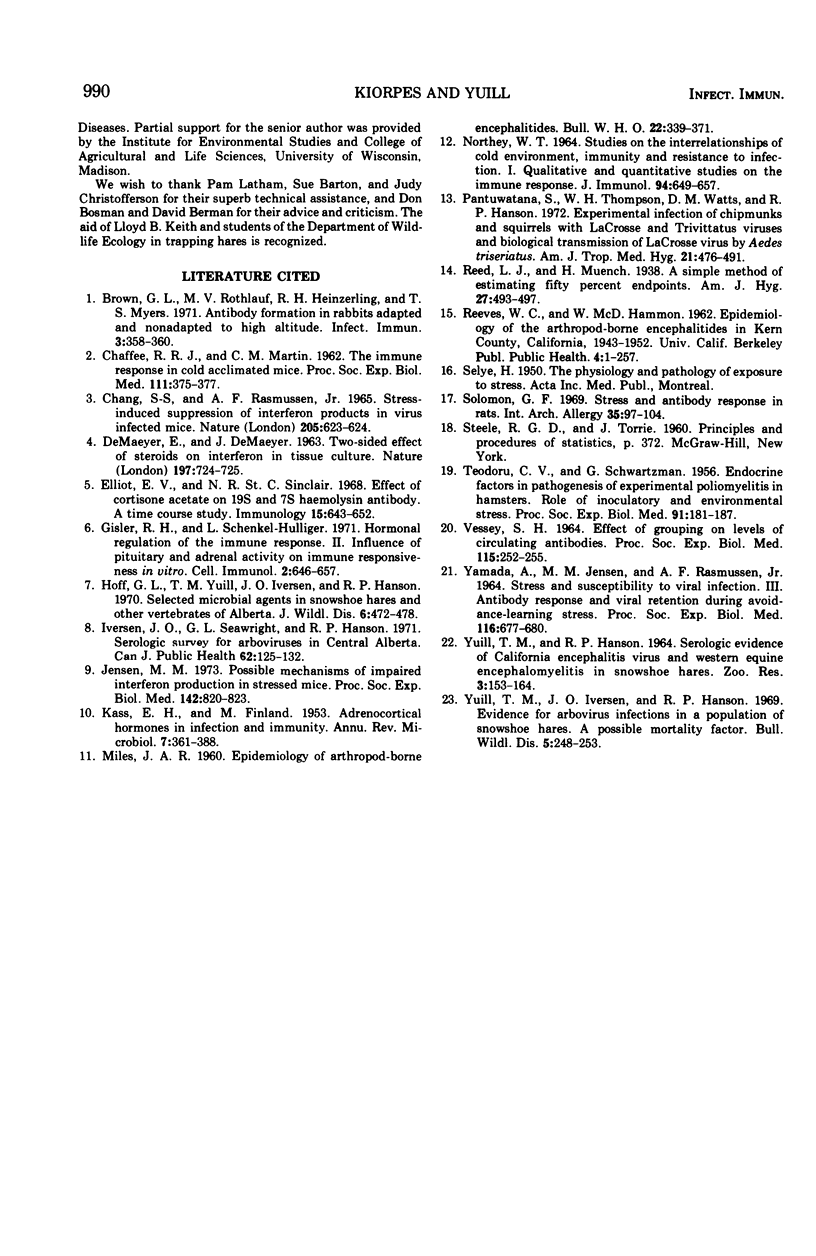
Selected References
These references are in PubMed. This may not be the complete list of references from this article.
- Brown G. L., Rothlauf M. V., Heinzerling R. H., Myers T. S. Antibody formation in rabbits adapted and nonadapted to high altitude. Infect Immun. 1971 Feb;3(2):358–360. doi: 10.1128/iai.3.2.358-360.1971. [DOI] [PMC free article] [PubMed] [Google Scholar]
- CHAFFEE R. R., MARTIN C. M. The immune response in cold-acclimated mice. Proc Soc Exp Biol Med. 1962 Nov;111:375–377. doi: 10.3181/00379727-111-27796. [DOI] [PubMed] [Google Scholar]
- DE MAEYER E., DE MAEYER J. Two-sided effect of steroids on interferon in tissue culture. Nature. 1963 Feb 16;197:724–725. doi: 10.1038/197724a0. [DOI] [PubMed] [Google Scholar]
- Elliott E. V., Sinclair N. R. Effect of cortisone acetate on 19S and 7S haemolysin antibody. A time course study. Immunology. 1968 Nov;15(5):643–652. [PMC free article] [PubMed] [Google Scholar]
- Gisler R. H., Schenkel-Hulliger L. Hormonal regulation of the immune response. II. Influence of pituitary and adrenal activity on immune responsiveness in vitro. Cell Immunol. 1971 Dec;2(6):646–657. doi: 10.1016/0008-8749(71)90012-8. [DOI] [PubMed] [Google Scholar]
- Hoff G. L., Yuill T. M., Iversen J. O., Hanson R. P. Selected microbial agents in snowshoe hares and other vertebrates of Alberta. J Wildl Dis. 1970 Oct;6(4):472–478. doi: 10.7589/0090-3558-6.4.472. [DOI] [PubMed] [Google Scholar]
- Iversen J. O., Seawright G., Hanson R. P. Serologic survey for arboviruses in Central Alberta. Can J Public Health. 1971 Mar-Apr;62(2):125–132. [PubMed] [Google Scholar]
- Jensen M. M. Possible mechanisms of impaired interferon production in stressed mice. Proc Soc Exp Biol Med. 1973 Mar;142(3):820–823. doi: 10.3181/00379727-142-37124. [DOI] [PubMed] [Google Scholar]
- KASS E. H., FINLAND M. Adrenocortical hormones in infection and immunity. Annu Rev Microbiol. 1953;7:361–388. doi: 10.1146/annurev.mi.07.100153.002045. [DOI] [PubMed] [Google Scholar]
- MILES J. A. Epidemiology of the arthropod-borne encephalitides. Bull World Health Organ. 1960;22:339–371. [PMC free article] [PubMed] [Google Scholar]
- NORTHEY W. T. STUDIES ON THE INTERRELATIONSHIP OF COLD ENVIRONMENT, IMMUNITY AND RESISTANCE TO INFECTION. I. QUALITATIVE AND QUANTITATIVE STUDIES ON THE IMMUNE RESPONSE. J Immunol. 1965 May;94:649–657. [PubMed] [Google Scholar]
- Pantuwatana S., Thompson W. H., Watts D. M., Hanson R. P. Experimental infection of chipmunks and squirrels with La Crosse and Trivittatus viruses and biological transmission of La Crosse virus by Aedes triseriatus. Am J Trop Med Hyg. 1972 Jul;21(4):476–481. doi: 10.4269/ajtmh.1972.21.476. [DOI] [PubMed] [Google Scholar]
- REEVES W. C., HAMMON W. M., LONGSHORE W. A., Jr, McCLURE H. E., GEIB A. F. Epidemiology of the arthropod-borne viral encephalitides in Kern County, California, 1943-1952. Publ Public Health Univ Calif. 1962 Jun 6;4:1–257. [PubMed] [Google Scholar]
- Solomon G. F. Stress and antibody response in rats. Int Arch Allergy Appl Immunol. 1969;35(1):97–104. doi: 10.1159/000230163. [DOI] [PubMed] [Google Scholar]
- TEODORU C. V., SHWARTZMAN G. Endocrine factors in pathogenesis of experimental poliomyelitis in hamsters; role of inoculatory and environmental stress. Proc Soc Exp Biol Med. 1956 Feb;91(2):181–187. doi: 10.3181/00379727-91-22206. [DOI] [PubMed] [Google Scholar]
- VESSEY S. H. EFFECTS OF GROUPING ON LEVELS OF CIRCULATING ANTIBODIES IN MICE. Proc Soc Exp Biol Med. 1964 Jan;115:252–255. doi: 10.3181/00379727-115-28883. [DOI] [PubMed] [Google Scholar]
- YAMADA A., JENSEN M. M., RASMUSSEN A. F., Jr STRESS AND SUSCEPTIBILITY TO VIRAL INFECTIONS. 3. ANTIBODY RESPONSE AND VIRAL RETENTION DURING AVOIDANCE LEARNING STRESS. Proc Soc Exp Biol Med. 1964 Jul;116:677–680. doi: 10.3181/00379727-116-29342. [DOI] [PubMed] [Google Scholar]
- Yuill T. M., Hanson R. P. Serologic evidence of California encephalitis virus and western equine encephalitis virus in snowshoe hares. Zoonoses Res. 1964 Aug;3(3):153–164. [PubMed] [Google Scholar]
- Yuill T. M., Iversen J. O., Hanson R. P. Evidence for arbovirus infections in a population of snowshoe hares: a possible mortality factor. Wildl Dis. 1969 Jul;5(3):248–253. doi: 10.7589/0090-3558-5.3.248. [DOI] [PubMed] [Google Scholar]


